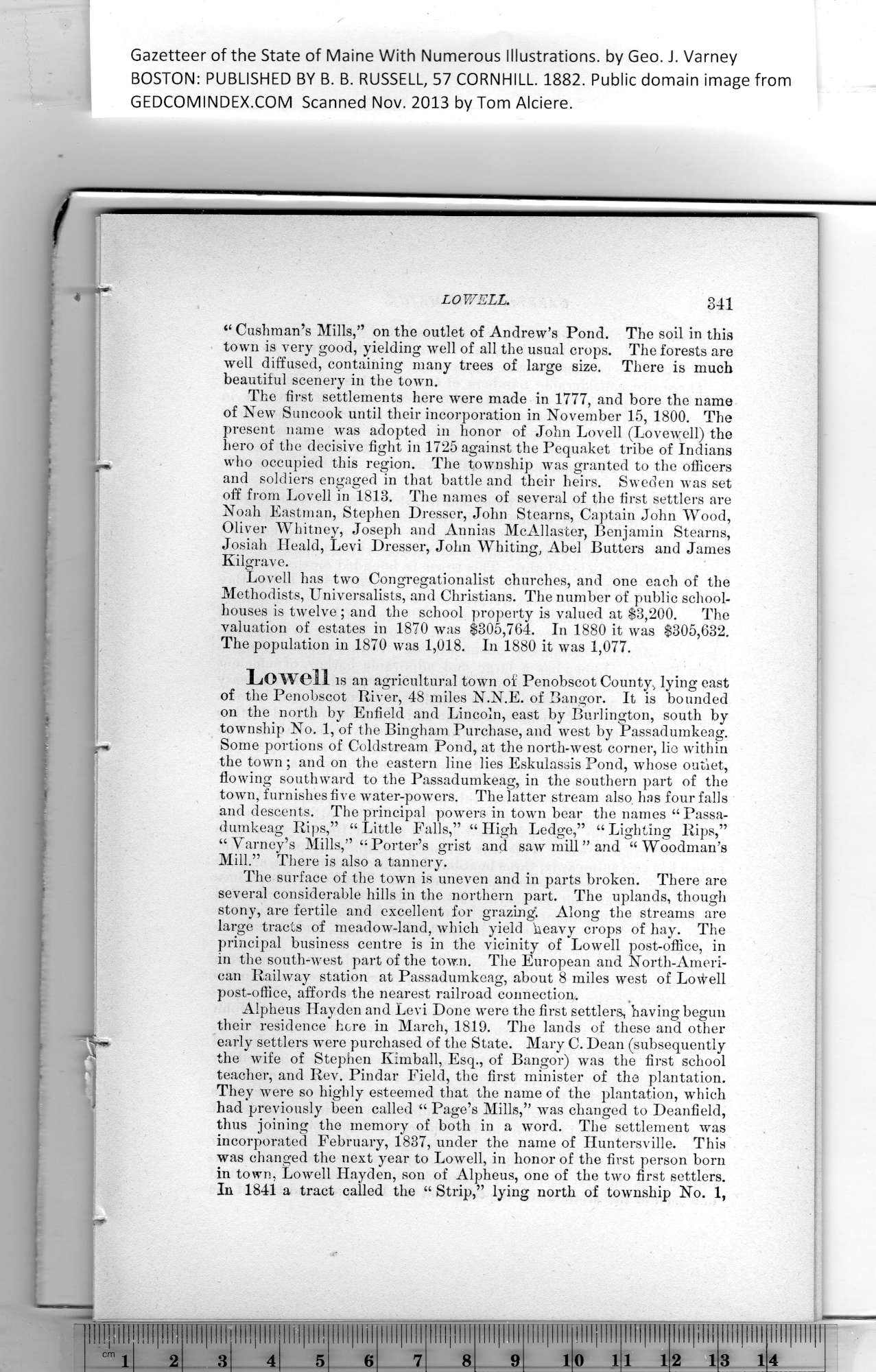|
Gazetteer of the State of Maine With Numerous Illustrations, by Geo. J. Varney
BOSTON: PUBLISHED BY B. B. RUSSELL, 57 CORNHILL. 1882. Public domain image from
LOWELL. 341
“ Cushman’s Mills,” on the outlet of Andrew’s Pond. The soil in this
town is very good, yielding well of all the usual crops. The forests are
well diffused, containing many trees of large size. There is much
beautiful scenery in the town.
The first settlements here were made in 1777, and bore the name
of New Suncook until their incorporation in November 15, 1800. Tbe
present name was adopted in honor of John Lovell (Lovewell) the
hero of the decisive fight in 1725 against the Pequaket tribe of Indians
who occupied this region. The township was granted to tbe officers
and soldiers engaged in that battle and their heirs. Sweden was set
off from Lovell in 1813. The names of several of the first settlers are
Noah Eastman, Stephen Dresser, John Stearns, Captain John Wood,
Oliver Whitney, Joseph and Annias McAllaster, Benjamin Stearns,
Josiah Heald, Levi Dresser, John Whiting, Abel Butters and James
Kilg rave.
Lovell has two Congregationalist churches, and one each of the
Methodists, Universalists, and Christians. The number of public school-
houses is twelve ; and the school property is valued at $3,200. The
valuation of estates in 1870 was $305,764. In 1880 it was $305,632.
The population in 1870 was 1,018. In 1880 it was 1,077.
Lowell is an agricultural town of Penobscot County, lying east
of the Penobscot River, 48 miles N.N.E. of Bangor. It is bounded
on the north by Enfield and Lincoln, east by Burlington, south by
township No. 1, of the Bingham Purchase, and west by Passadumkeag.
Some portions of Coldstream Pond, at the north-west corner, lie within
the town; and on the eastern line lies Eskulassis Pond, whose outlet,
flowing southward to the Passadumkeag, in the southern part of the
town, furnishes five water-powers. The latter stream also, has four falls
and descents. The principal powers in town hear the names “ Passa-
dumkeag Rips,” “ Little Falls,” “ High Ledge,” “ Lighting Rips,”
“Varney’s Mills,” “Porter’s grist and saw mill’’and “Woodman’s
Mill.” There is also a tannery.
The surface of the town is uneven and in parts broken. There are
several considerable hills in the northern part. The uplands, though
stony, are fertile and excellent for grazingl Along the streams are
large tracts of meadow-land, which yield heavy crops of hay. The
principal business centre is in the vicinity of Lowell post-office, in
in tbe south-west part of the town. The European and North-Ameri-
can Railway station at Passadumkeag, about 8 miles west of Lowell
post-office, affords the nearest railroad connection.
Alpheus Hayden and Levi Done were the first settlers, having begun
their residence here in March, 1819. The lands of these and other
early settlers were purchased of tbe State. Mary C. Dean (subsequently
the wife of Stephen Kimball, Esq., of Bangor) was the first school
teacher, and Rev. Pindar Field, the first minister of the plantation.
They were so highly esteemed that the name of the plantation, which
had previously been called “ Page’s Mills,” was changed to Deanfield,
thus joining the memory of both in a word. The settlement was
incorporated February, 1837, under the name of Huntersville. This
was changed the next year to Lowell, in honor of the first person born
in town, Lowell Hayden, son of Alpheus, one of the two first settlers.
In 1841 a tract called the “ Strip,” lying north of township No. 1,
PREVIOUS PAGE ... NEXT PAGE
This page was written in HTML using a program written in Python 3.2
|
